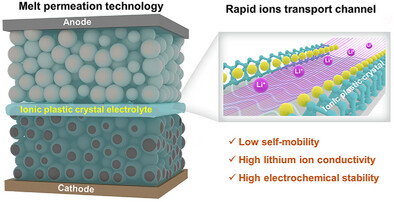Electric Field-Induced Fast Li-Ion Channels in Ionic Plastic Crystal Electrolytes for All-Solid-State Batteries
Xinyu Ma1, Jiangtao Yu1, Xiuyang Zou1, Xiaoliang Wang2, Huihui Wang2, Yin Hu1, Minzhi Duan2, Songlin Tao2, Shipeng Sun1, Yanbin Shen3, Feng Yan1(严锋)*
1Jiangsu Engineering Laboratory of Novel Functional Polymeric Materials, Jiangsu Key Laboratory of Advanced Negative Carbon Technologies, Suzhou Key Laboratory of Soft Material and New Energy, College of Chemistry, Chemical Engineering and Materials Science, Soochow University, Suzhou 215123, P.R. China
2School of Chemistry and Chemical Engineering, Nanjing University, Nanjing 210023, P.R. China
3i-Lab, CAS Center for Excellence in Nano science, Suzhou Institute of Nano-Tech and Nano-Bionics (SINANO), Chinese Academy of Sciences, Suzhou 215123, P.R. China
Angew. Chem. Int. Ed.2025,64,e202505035
Abstract: The practical use of all-solid-state batteries (ASSBs) is hindered by the intractable electrolyte/electrode interfacial resistance and discontinuous ion transport networks within electrodes. Ionic plastic crystals offer a potential solution to these challenges due to their melt-permeable properties to the electrodes. However, their limited ionic conductivity restricts their application. Here, we propose a design principle for solid-state electrolytes based on an electric field-induced strategy by using ionic plastic crystals with low self-migrating and high conductivity toward target ions. Through the external potential difference, an ordered internal electric field is generated within the ionic plastic crystal-based solid-state electrolytes (IPCEs), which mitigates the coordination limitations of anions on target ions to facilitate rapid ion conduction. The prepared IPCE demonstrates high ionic conductivity (1.08 × 10−3 S cm−1 at 25 °C) and a Li+ transfer number (0.77), enabling the application of ASSBs over a wide temperature range (from 0 to 60 °C). Furthermore, the assembled Li||LiNi0.8Co0.1Mn0.1O2 ASSBs exhibit stable cycling, maintaining 97.5% capacity retention after 500 cycles at 25 °C. This work provides a fresh perspective on the practical application of ASSBs, highlighting the potential of IPCEs in enhancing battery performance.

Article information: //doi.org/10.1002/anie.202505035